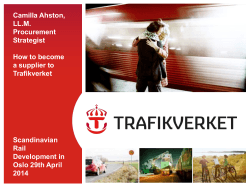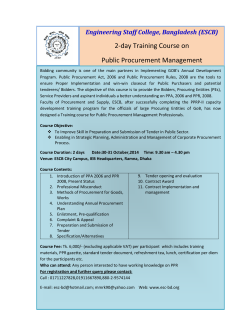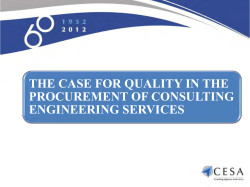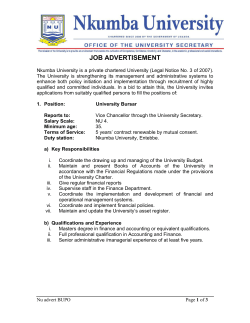
Source-to-Settle: Why It Is Time to Connect the Last Mile
Source-to-Settle:
Why It Is Time to Connect
the Last Mile
Underwritten by:
Andrew Bartolini,
Chief Research Officer
Ardent Partners
October, 2014
Source-to-Settle: Why It Is Time to Connect the Last Mile
REPORT SPONSORSHIP
1
The views and opinions in this report represent those of Ardent Partners at the time of publication.
While the report topic was agreed upon in advance, Ardent singularly determined the research
approach taken and the report’s final content including its ideas, strategies, case studies, and
recommendations. The contents of this research report are the exclusive property of Ardent
Partners. Please direct any comments or questions regarding our research sponsorship policy to
Ardent’s Chief Research Officer, Andrew Bartolini at abartolini@ardentpartners.com and/or
617.752.1620.
Sponsor:
Ariba is the world’s business commerce network. Ariba combines industry-leading cloud-based
applications with the world’s largest web-based trading community to help companies discover
and collaborate with a global network of partners. Using the Ariba® Network, businesses of all sizes
can connect to their trading partners anywhere, at any time, from any application or device to buy,
sell, and manage their cash more efficiently and effectively than ever before. Companies around
the world use the Ariba Network to simplify inter-enterprise commerce and enhance the results
that they deliver. Join them at: www.ariba.com
Contact:
Erin Hannaford
Senior Marketing Manager, Global Campaigns
Ariba, Inc.
+1.678.336.2796
ehannaford@ariba.com
©2014 Ardent Partners, Ltd.
www.ardentpartners.com
Source-to-Settle: Why It Is Time to Connect the Last Mile
2
Procurement's expansion of influence and control within the enterprise has been driven, in no small
part, by its ability to drive value across its core processes. Until recently, technology and organizational
barriers conspired to keep organizations from managing a holistic source-to-settle process. In 2014, the
time is right to connect the last mile. This report looks at the opportunities that procurement
departments have to connect their strategic sourcing and procure-to-pay processes.
The Source-to-Settle Process
Every enterprise in the world buys goods and services to
help make its business run. So, whether formalized or not,
every enterprise has a procurement team in some way,
shape, or form. However, just because an enterprise buys
things, does not mean it buys them well or that there is a
process used to buy them intelligently. The frank reality is
that even established procurement teams can fail to
design and use a process that allows for enterprise-level alignment across the source-to-settle
process. Ardent Partners research shows that in 2014, a standardized, linked, and/or automated
source-to-settle process remains the exception and not the rule with only 24.3% of all enterprises
reporting that they have and follow a standardized and complete source-to-settle process. The
number drops to 19.9% when looking at the percentage of all enterprises who have fully
automated their source-to-settle process.
What do we mean by the “source-to-settle” process? As shown in Figure 1 below, this process
combines the activities of sourcing for critical supplies and services (frequently referred to as
either "strategic sourcing" or "upstream" activities) with the contract and relationshipmanagement components including purchasing, invoice processing and payments (frequently
referred to as either "procure-to-pay" or "downstream" activities) whereby the procurement
department serves as a primary point of contact for the supplier through the sourcing and
purchasing processes before the accounts payable team takes over and manages the supplier
invoice and payment processes.
Figure 1: The Source-to-Settle Process
© Ardent Partners - 2014
Why Does "Source-to-Settle" Matter?
Imagine the car-buying process. In an earlier age, consumers walked into the dealership and
listened to the salesperson go on and on about the various models at that particular dealership.
Time-permitting, the consumer would then drive to one, or possibly, two other dealerships (if they
©2014 Ardent Partners, Ltd.
www.ardentpartners.com
Source-to-Settle: Why It Is Time to Connect the Last Mile
were nearby) and hear the same spiel. Eventually, that consumer probably bought whatever
brand they trusted the most.
3
The advent of the Internet changed all that. Now, that fictional consumer can visit hundreds of
websites to read reviews and find out which car gets the best gas mileage, has the highest safety
rating, or even possesses the most horsepower and whatever is most important to that particular
consumer at that particular time. Car price information of some reputable quality is also available
online. This ultimately arms the average consumer with valuable information to negotiate with the
salesperson and get the best possible deal for his/her money.
The fictional car buyer best describes strategic sourcing, which is a key component of a robust
procurement organization. The source-to-settle process adds an additional dimension of value to
the entire procedure by matching the efforts spent identifying the highest-value suppliers via
sourcing with robust processes designed to manage the relationship and associated contracts and
categories. Enterprises often have a single relationship with a supplier, and often a single
transaction for a vast quantity of valuable product. A robust source-to-settle process allows for this
relationship to be maintained throughout the entire transactional flow and for the entire contract
duration.
The standard procure-to-pay (P2P) workflow involves passing the proverbial baton - in this case
the supplier - off to multiple teams from the time they ship their goods (or deliver their service) to
the time they get paid. At any point along the way, the process could break down and the supplier
could possibly fall through the cracks. This can create relationship issues and erode the potential
value of the transaction from a savings and efficiency perspective, while also being disruptive to
the supplier's operations and business.
What Source-to-Settle Can Do
Seamless source-to-settle processes can capture and retain value efficiently and effectively in a
repeatable and scalable way. A robust source-to-settle process also does more than simply
manage supplier relationships. By linking sub-process areas like spend analysis with sourcing and
eProcurement with accounts payable, the value created in one area is carried forward and often
amplified within the next connected sub-process. For example, spend analysis can be used to help
procurement departments understand the scope of what, where, how, how much, and with which
suppliers money is spent and help their sourcing teams pinpoint savings opportunities and
financial trends across the entirety of enterprise spend. However, it is only when this spend
information is used to prioritize sourcing pipelines, structure sourcing events, identify suppliers,
and negotiate contracts that real value is created. Similarly, an invoice that is created or "flipped"
from a system generated purchase order ("PO") is basically assured to match the original PO and
therefore has a significantly greater chance to be processed "straight-through."
©2014 Ardent Partners, Ltd.
www.ardentpartners.com
Source-to-Settle: Why It Is Time to Connect the Last Mile
4
Numerous examples such as these exist across each sub-process area when it is tightly linked to
another. Better data integrity begets increased compliance and accuracy. Better visibility begets
superior decision-making. And, better integration begets improved efficiency. Et cetera. Despite
these opportunities, between 25% and 41% of all procurement departments in 2014 claim that no
linkage exists between the key sub-processes (see Figure 1 above) that define their source-to-settle
process.
Designing for Source-to-Settle Success
An investment in the creation, transformation, and/or automation of a source-to-settle process
can provide significant dividends, including but not limited to cost savings, process efficiencies,
and improved supplier relationships. In fact, the relentless pressure on bottom-line performance
should make this particular kind of investment a near necessity of modern business. But, since the
speed and level of return from such an initiative can vary widely, these projects require diligent
planning and an investment of time, money, and resources
No matter where a source-to-settle project starts, whether in sourcing, procurement, accounts
payable, or elsewhere, the most important aspect of the plan is to take a long-term and holistic
view. It is only through looking at the entire source-to-settle process - and what the organization
hopes to achieve with it - that long-term success can truly be wrought. Keep in mind as well that
an “all or nothing” mentality does not need to apply in this case. Many organizations entertain a
phased approach to source-to-settle projects, wherein different sub-process areas are attacked in
concert but, at different times. The most direct and effective path to source-to-settle success
begins with a plan that looks holistically across the entire process and incorporates and prioritizes
the requirements of all source-to-settle stakeholders.
Collaboration is King
Collaboration can come in many flavors, but it is really three that can make or break a source-tosettle project: people, systems, and processes.
Collaboration Among People
The source-to-settle process involves multiple internal and external stakeholders. In the purest
sense, however, the two teams that collaborate most directly are those focused on sourcing and
P2P. The team that focuses on sourcing should talk constantly with the group focused on the P2P
process flow. If sourcing finds the best deals on the most critical products and then is left out of
the loop when the P2P team gets its hands on the suppliers, then an information gap arises where
the sourcing pros may never know how successful they actually were in saving the company
money. To alleviate this particular concern, sourcing and P2P should regularly discuss each other’s
work. In this way, clear lines of communication within the department is forged and companies
get on the first rung of the ladder toward source-to-settle success. This communication also
©2014 Ardent Partners, Ltd.
www.ardentpartners.com
Source-to-Settle: Why It Is Time to Connect the Last Mile
creates higher levels of performance, which in turn can benefit procurement's attempts to extend
its influence across the enterprise.
Collaboration Among Systems
5
Collaboration among systems, otherwise known as integration, is increasingly prized by
procurement and P2P leaders as they continue to drive for efficiencies and visibility. And, with
end-user adoption and supplier enablement
Figure 2: Suite Adoption
serving as critical drivers in determining the
overall success of a technology deployment,
© Ardent Partners - 2014
43.4%
suites of solutions which share common user
35.9%
interfaces and logins are becoming more
desirable, particularly for organizations with
limited budgets for staff training and supplier
enablement. Beyond these potential benefits,
19.9%
enterprises are also increasingly interested in
limiting or reducing the number of technology
vendors they work with to ensure better
integration, less complex system architectures,
and fewer product release cycles.
Integrated
Procure-to-Pay
Suite
Integrated
Strategic
Sourcing Suite
Integrated
Source-to-Settle
Suite
As seen in Figure 2, 43.4% of all enterprises are
currently using an integrated procure-to-pay
suite which includes an eProcurement system with integration to an ePayables solution Likewise,
35.9% of all enterprises are currently using an integrated strategic sourcing suite which includes
spend analysis, eSourcing, and contract management while roughly one in five enterprises (19.9%)
have adopted a fully-integrated source-to-settle suite.
Collaboration Among Processes
The unvarnished truth is that a successful source-to-settle workflow must look at the entire
ecosystem that connects sourcing to procurement to accounts payable to treasury. A truly holistic
source-to-settle process touches all of these functions at some level, and it is because of this
broad-based impact that each team needs to collaborate with every other one on its portion of
the work. Imagine an orchestra playing a piece of classical music. The woodwinds, brass,
percussion, and strings need to all work together in order to bring "Beethoven’s Fifth" to life. A
flutist in the woodwinds section may be able to play his or her portion perfectly fine, but if the
timpani player in the back is not in the same rhythm, then the audience hears a discordant piece
of music. So it is as well with all the processes that make up the source-to-settle workflow; if each
one is not part of a coherent whole, then procurement teams run the risk of sounding a discordant
note heard across the entire enterprise.
©2014 Ardent Partners, Ltd.
www.ardentpartners.com
Source-to-Settle: Why It Is Time to Connect the Last Mile
Recommendations
6
When it comes right down to it, a source-to-settle process that has its people, processes, and
systems aligned and linked can be a highly-efficient, savings machine. This stems from a holistic
viewpoint in the source-to-settle workflow; when everyone is moving in the same direction,
enterprises can find new process efficiencies and cost savings that were not previously apparent.
The incremental gains achieved through each process linkage can, in turn, become somewhat
exponential when taken as a whole. Value found in sourcing cascades to the larger procurement
organization, which translates into efficiencies in accounts payable, and even down the line to the
cash management needs of treasury. The foundation of a successful source-to-settle project is not
built in any single department, but rather, cross-functionally using the knowledge and expertise of
multiple teams to make the workflow the most efficient it can possibly be. To make this happen
for enterprises that might not currently have a source-to-settle initiative in place, Ardent Partners
recommends the following:
•
•
•
•
•
Develop a source-to-settle blueprint that includes input from all relevant internal stakeholders
and focuses on the final end-state of the initiative
Place any current programs, systems and processes into a larger source-to-settle context
Look beyond mere cost savings to the true value of source-to-settle initiatives in building
relationships
Develop an environment of trust and communication among departments and with suppliers
and sell the value of their participation in the initiative
Embed the procurement staff within line of business groups to improve communication and
collaboration to then expand influence and place more spend under management
Conclusion
Building a source-to-settle organization involves engagement and commitment from the
executive ranks and the definition of clear goals and objectives for the combined sourcing,
procurement, and financial operations functions. Implementing a full source-to-settle process is
not an easy task, particularly in the multi-faceted world of corporate procurement and accounts
payable. And yet, without a robust source-to-settle program in place, enterprises may lose out on
many of the benefits generated from an integrated process. There are certainly ways to find cost
savings in the discrete areas that form a source-to-settle workflow, but without the tight
connections across departmental boundaries, technologies, and process flows, enterprises may
soon find themselves losing ground to the competition.
A fully functional source-to-settle process is clearly more than a nice-to-have; it is critically
important to the health of the entire enterprise. Where budgets allow, Ardent Partners advises
enterprises to connect that last mile of the source-to-settle process as soon as possible. And,
where budgets do not exist, Ardent Partners advises that teams begin working in earnest to build
a justification for one. It is time.
©2014 Ardent Partners, Ltd.
www.ardentpartners.com
Source-to-Settle: Why It Is Time to Connect the Last Mile
APPENDIX
ABOUT ARDENT PARTNERS
7
Ardent Partners is a Boston-based research and advisory firm focused on defining and advancing
the supply management strategies, processes, and technologies that drive business value and
accelerate organizational transformation within the enterprise. Ardent also publishes the CPO
Rising and Payables Place websites. Register for exclusive access (and discounts) to Ardent
Partners research at ardentpartners.com/newsletter-registration/.
ABOUT THE AUTHORS
Andrew Bartolini, Chief Research Officer, Ardent Partners
Andrew Bartolini is a globally-recognized expert in sourcing, procurement,
accounts payable, and supply management. Andrew focuses his research and
efforts on helping enterprises develop and execute strategies to achieve
operational excellence within their procurement and finance departments.
Andrew is also the publisher of CPO Rising (www.cporising.com) and Payables
Place (www.payablesplace.com), two highly popular sites focused on defining
and advancing industry best practices in the supply management realm.
Advisor to CPOs and leading solution providers alike, Andrew is a sought-after presenter, having
lectured and presented more than 150 times in seven different countries. Over the past decade
years, Andrew has benchmarked thousands of enterprises across all facets of their sourcing,
procurement, accounts payable, and supply management operations and his research is currently
part of the Supply Chain/Management curriculum at several US universities. He actively covers the
technology marketplace as well as trends in sourcing, procurement, supply management, and
accounts payable and has been published or quoted in leading business publications including
The Wall Street Journal, Business Week, Investor’s Business Daily, Forbes, and Fortune, as well as
the major trade publications focused on supply management.
Prior to becoming an industry analyst, Andrew developed, packaged, deployed, and used supply
management solutions on behalf of enterprises in the Global 2000 while working for Ariba and
Commerce One. Additionally, his experience in strategic sourcing (where he managed sourcing
projects totaling more than $500 million in aggregate client spend), business process
transformation, and software implementation provides a ‘real-world’ context for his research and
writing.
Andrew has been named a “Pro to Know” by Supply and Demand Chain Executive three times and
holds a B.A. in Economics from The College of the Holy Cross and an M.B.A in Finance from Indiana
University. He welcomes your comments at abartolini@ardentpartners.com or 617.752.1620.
©2014 Ardent Partners, Ltd.
www.ardentpartners.com
Source-to-Settle: Why It Is Time to Connect the Last Mile
Matthew Delman, Senior Content Strategist and Payables Researcher
8
In his long and varied career, Matthew Delman has worked as an editor, writer,
and/or online marketer for The Eagle-Tribune Newspaper Group, The NASDAQ
OMX Group, an investment newsletter, and a research-focused marketing
services firm. Over the course of nearly 15 years as an editorial professional,
Matthew has had a hand in the development of more than 2 million pages
worth of print and online content.
His research focus at Ardent Partners includes the entire accounts payable
workflow including B2B payments, global tax and trade, and third-party financing. Matthew is also
the lead writer and editor for Payables Place (www.payablesplace.com), and focuses on keeping
the site updated with a constant stream of fresh and interesting research, news, and analysis from
the world of AP automation. He is available for briefing requests and/or third-party article
contributions at mdelman@ardentpartners.com.
©2014 Ardent Partners, Ltd.
www.ardentpartners.com
Source-to-Settle: Why It Is Time to Connect the Last Mile
RESEARCH METHODOLOGY
9
Ardent Partners follows a rigorous research process developed over years spent researching the
supply management market. The research in this report represents the web-based survey
responses of 273 CPOs and other procurement and business leaders captured in January, 2014 as
well as direct interviews with 24 CPOs and procurement leaders (20 of whom took the survey).
These 273 participants shared their strategies and intentions, as well as their operational and
performance results to help us define Best-in-Class procurement performance and understand
what levers the leading groups pull to obtain their advantage. Roughly two-thirds of the total
participants shared some personal insight and commentary to help provide greater context to the
results. This primary research effort was also informed by the experience and analysis of the report
author and the entire Ardent Partners research team. Complete respondent demographics are
included below.
To purchase reprints of this report, please email research@ardentpartners.com. For more
information on this and similar topics, please visit www.cporising.com and the research library at
www.ardentpartners.com.
REPORT DEMOGRAPHICS
The research in this report is drawn from respondents representing the following demographics:
•
Job Function: 87% procurement; 5% finance; 4% supply chain; 4% other
•
Job Role: 42% VP-level or higher; 30% director-level; 23% manager-level; 5% staff-level
•
Company Revenue: 64% Large (revenue > $1 billion); 17% Mid-market (revenue between
$250 million and $1 billion); 19% Small (revenue < $250 million)
•
Region: 69% North America; 21% EMEA; 10% Asia-Pacific
•
Industry: More than 25 distinct industries are represented. Public Sector, Health Care,
Financial Services, High-tech, and Manufacturing are the largest industries in the survey
pool; no industry represents more than 12% of the overall survey respondents.
Industry Standard “Fine Print:” The information contained herein has been obtained from sources believed to be reliable. Ardent
Partners, Ltd. disclaims all warranties as to the accuracy, completeness, or adequacy of such information. Ardent Partners, Ltd. shall
have no liability for errors, omissions, or inadequacies in the information contained herein or for interpretations thereof. The contents
expressed herein represent Ardent Partners’ best analysis at the time and are subject to change without notice.
© 2014 Ardent Partners, Ltd. All rights reserved. Reproduction and distribution of this publication in any form without prior written
permission is forbidden. Solution providers and consultancies should take special note that Ardent Partners reserves the right to seek
legal remedies including injunctions, impoundment, destruction, damages, and fees for any copyright infringement (which includes
but is not limited to usage of any Ardent Partners content in company collateral, presentations, and websites) in accordance with the
laws of the Commonwealth of Massachusetts and the United States.
©2014 Ardent Partners, Ltd.
www.ardentpartners.com
© Copyright 2025









